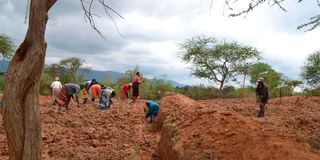The role of community land rights in rehabilitating degraded land

Men and women members of Umiisyo wa kwa Kathee join hands to rehabilitate degraded land in their village
What you need to know:
- With 2030 fast approaching, one workable plan is supporting communities to participate in managing and conserving forests effectively.
- This is a way to go beyond national planning and development frameworks to identify pathways that can fully realise the potential of restoration.
The United Nations Convention to Combat Desertification (UNCCD) recently warned of the rapid loss of healthy and productive land worldwide, threatening food and water security. In the report, UNCCD, responsible for linking environment and development to sustainable land management, noted that the world must restore about 1.5 billion hectares of degraded land by 2030 to reach land degradation neutrality (LDN) targets enshrined in the Sustainable Development Goals.
This is despite land degradation trends varying by region. UNCCD marks degraded land restoration essential to combat climate change, ensure food security and protect biodiversity. Communities are crucial in this process, but only if their land rights are secure.
Kenya is among the countries that have set voluntary LDN targets for 2030, including a target to restore 5.1 million hectares of land. In addition, the current government has also pledged to plant 15 billion trees over the next 15 years as part of the country's climate action agenda.
With 2030 fast approaching, one workable plan is supporting communities to participate in managing and conserving forests effectively. This is a way to go beyond national planning and development frameworks to identify pathways that can fully realise the potential of restoration. To effectively achieve this in a manner that does not threaten the livelihoods of communities in areas targeted for restoration but instead ensures communities are the stewards and champions of repair, we need to secure their land and tenure rights.
A recent research conducted by German think-tank TMG Research in Kenya (in partnership with Kenya Land Alliance in Taita Taveta and Narok Counties), Benin, Malawi and Madagascar shows a strong correlation between communities' tenure rights and land rights and their investment in sustainable land management practices.
Communities often invest more in techniques to restore degraded lands and prevent further degradation when their rights to access, use and manage these lands are recognised and secured. Without securing land and tenure rights, communities view the land restoration agenda and their quest to support their livelihoods as competing interests. In contrast, none should be achieved at the expense of the other.
Ways to boost communities' land rights and support their participation in degraded lands restoration include;
1. Improve community recognition of land rights by registering community forest parcels as community lands. This will encourage sustainable land management and enable better forest monitoring and protection, safeguarding tenure and resource rights for all community members.
2. Empower communities to contribute to forest protection, conservation and landscape restoration with support from county governments. This support should align with national and sub-national conservation targets and enhance community institutions' capacity for these activities before and after registration.
3. Strengthen national efforts to achieve LDN and landscape restoration goals by identifying and involving essential community forests. Include community forests in direct actions for forest protection and consider consolidating smaller parcels for more effective conservation. Payment for ecosystem services (PES) can incentivise communities to prioritise forest protection.
4. Incorporate tenure issues into national LDN targets and forest conservation initiatives by integrating them into Kenya's forest co-management framework data collection and monitoring efforts, thus integrating tenure concerns into LDN measures and impact assessment.





